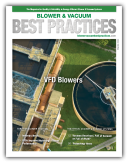Republic Manufacturing Delivers Food Grade Blower & Air Knife Systems
Blower & Vacuum Best Practices interviewed Republic Manufacturing VP of Sales & Marketing, Rich Leong.
Our line of regenerative blowers, also known as side channel blowers, are for vacuum or compressed air applications in both horizontal and vertical mounted positions. Airflow capabilities range from 50 to 776 CFM, vacuum capabilities from 47" to 236" of water (1.7 psi to 8.53 psi) and pressure capabilities up from 47" to 307" of water (1.7 psi to 11.09). TEFC electric motors are cUL and CE certified and come in single and three-phase, dual frequency and multi-voltage versions for worldwide applications. Horsepower ranges from 1/2 to 40 HP (from 0.4 to 30kW).


